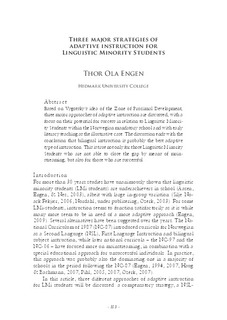Three major strategies of adaptive instruction for linguistic minority students
Chapter
Permanent lenke
http://hdl.handle.net/11250/134212Utgivelsesdato
2009Metadata
Vis full innførselSamlinger
Originalversjon
Engen, T. O. (2009). Three major strategies of adaptive instruction for linguistic minority students. I B.-K. Ringen & O. K. Kjørven (Red.); A. Gagné (Hon. ed.), Teacher diversity in diverse schools: Challenges and opportunities for teacher education (s. 353-369). Vallset: Oplandske bokforlag.Sammendrag
Based on Vygotsky’s idea of the Zone of Proximal Development,
three major approaches of adaptive instruction are discussed, with a
focus on their potential for success in relation to Linguistic Minority
Students within the Norwegian mandatory school and with early
literacy teaching as the illustrative case. The discussion ends with the
conclusion that bilingual instruction is probably the best adaptive
type of instruction. This is true not only for those Linguistic Minority
Students who are not able to close the gap by means of mainstreaming,
but also for those who are successful.
Utgiver
Oplandske bokforlagBeslektede innførsler
Viser innførsler beslektet ved tittel, forfatter og emneord.
-
Combining capacity for instructional leadership with individual core practices in the Norwegian policy context
Jenssen, Mette Marit; Paulsen, Jan Merok (Peer reviewed; Journal article, 2022)This study explores how Norwegian school leaders develop their capacity for instructional leadership, a leadership style that is strongly related to school effectiveness and school improvement across a range of national ... -
Increasing inclusion through differentiated instruction in a technology-rich primary school classroom in Norway
Johler, Minttu Minna Sirena; Krumsvik, Rune Johan (Peer reviewed; Journal article, 2022)In this case study, the aim was to investigate how primary school teachers in a leading-edge Norwegian primary school use digital technologies to differentiate instruction to promote a more inclusive learning environment ... -
Home environmental factors influencing performance and progress of primary school pupils in Windhoek
Wikan, Gerd; Mostert, Louise (Journal article; Peer reviewed, 2011)Low educational outcome is a problem in Namibia. This might be explained as a function of several factors such as socioeconomic background, child input and school internal factors. These factors must all be taken into ...
